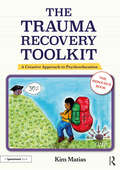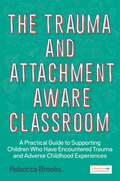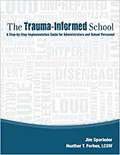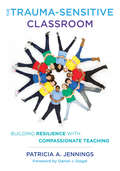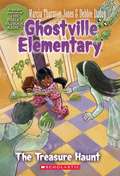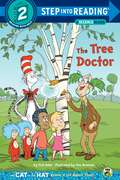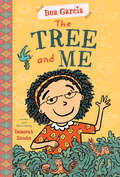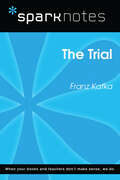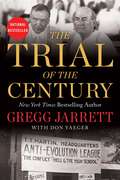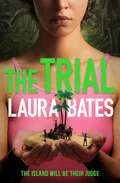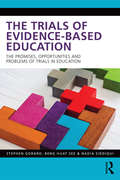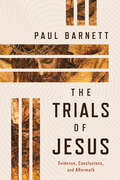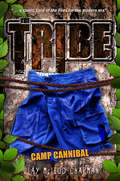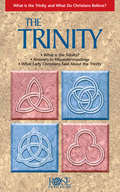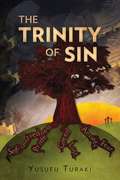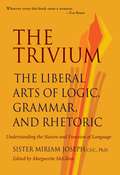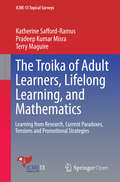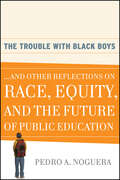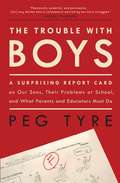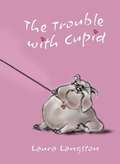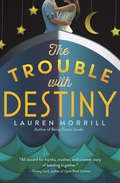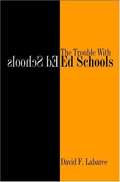- Table View
- List View
The Trauma Recovery Toolkit: A Creative Approach to Psychoeducation (The Trauma Recovery Toolkit)
by Kim MatiasThis guidebook is part of The Trauma Recovery Toolkit and needs to be purchased alongside the flashcards for full and effective use. Both can be purchased together as a set: 978-0-367-54690-8 This guidebook is part of The Trauma Recovery Toolkit, a guidebook and flashcard set that has been created to empower individuals living with the effects of trauma and the mental health professionals that support them. Inspired by the latest research surrounding mindfulness, self-compassion, neuroscience and trauma recovery, the resource explores the effect of trauma on the brain and body and offers strategies which may be helpful in combatting the symptoms. The flashcard format enables trauma survivors to creatively respond to visual aids and prompts in a way that is comfortable for them, providing mental health professionals with a more creative and person-centred approach to directing clients towards their own healing journey. This resource comprises: • 38 colourful flashcards that can be used as standalone visual aids or as a platform for creative responses • A guidebook delving into the individual cards, their meaning and symbolism, and the research behind them • Additional resources to support the client’s development of their own personalised cards. Weaving together psychoeducation, creativity, symbolism, and the latest neuroscientific research, this essential toolkit offers all professionals working in mental health services a creative way to engage clients with therapy, empowering them to develop habits and ways of being that can support their recovery. Intended for use in educational settings and/or therapy contexts under the supervision of an adult. This is not a toy.
The Trauma Recovery Toolkit: A Creative Approach to Psychoeducation (The Trauma Recovery Toolkit)
by Kim MatiasThis guidebook is part of The Trauma Recovery Toolkit and needs to be purchased alongside the flashcards for full and effective use. Both can be purchased together as a set: 978-0-367-54690-8This guidebook is part of The Trauma Recovery Toolkit, a guidebook and flashcard set that has been created to empower individuals living with the effects of trauma and the mental health professionals that support them.Inspired by the latest research surrounding mindfulness, self-compassion, neuroscience and trauma recovery, the resource explores the effect of trauma on the brain and body and offers strategies which may be helpful in combatting the symptoms. The flashcard format enables trauma survivors to creatively respond to visual aids and prompts in a way that is comfortable for them, providing mental health professionals with a more creative and person-centred approach to directing clients towards their own healing journey.This resource comprises: 38 colourful flashcards that can be used as standalone visual aids or as a platform for creative responses A guidebook delving into the individual cards, their meaning and symbolism, and the research behind them Additional resources to support the client’s development of their own personalised cards Weaving together psychoeducation, creativity, symbolism, and the latest neuroscientific research, this essential toolkit offers all professionals working in mental health services a creative way to engage clients with therapy, empowering them to develop habits and ways of being that can support their recovery.Intended for use in educational settings and/or therapy contexts under the supervision of an adult. This is not a toy.
The Trauma and Attachment-Aware Classroom: A Practical Guide to Supporting Children Who Have Encountered Trauma and Adverse Childhood Experiences
by Rebecca BrooksOffering teachers and other education staff guidance on how to work with children who have experienced trauma, this practical book is full of hands-on tips and guidance as to the most effective ways they can offer support. It covers a wide breadth of topics such as behavioural issues and home and school co-operation.
The Trauma-Informed School: A Step-by-Step Implementation Guide for Administrators and School Personnel
by Lcsw Heather T. Forbes Jim SporlederThe Trauma-Informed School is an all-inclusive guide designed to give school administrators of any school (elementary, middle or high school), step-by-step instructions of how to turn a school of any size into a trauma-informed school. With over 250 pages of content, this guide gives you the protocols you need along with a link to download all the documents needed for a successful implementation. <p><p> This well written and well-organized guide was developed from the vast experience of a nationally recognized retired school principal and school consultant (Jim Sporleder) and a nationally recognized trauma expert (Heather T. Forbes, LCSW). The combined work of these two authors is a winning combination that will equip and empower you to become a trailblazer in the area of trauma-informed education.
The Trauma-Sensitive Classroom: Building Resilience With Compassionate Teaching
by Patricia A. Jennings<P><P>From the author of Mindfulness for Teachers, a guide to supporting trauma-exposed students. <P><P> Fully half the students in U.S. schools have experienced trauma, violence, or chronic stress. In the face of this epidemic, it falls increasingly to teachers to provide the adult support these students need to function in school. But most educators have received little training to prepare them for this role. <P><P> In her new book, Tish Jennings—an internationally recognized leader in the field of social and emotional learning—shares research and experiential knowledge about the practices that support students' healing, build their resilience, and foster compassion in the classroom. In Part I, Jennings describes the effects of trauma on body and mind, and how to recognize them in students' behavior. In Part II, she introduces the trauma-sensitive practices she has implemented in her work with schools. And in Part III, she connects the dots between mindfulness, compassion, and resilience. Each chapter contains easy-to-use, practical activities to hone the skills needed to create a compassionate learning environment.
The Treasure Haunt (Ghostville Elementary #11)
by Debbie Dadey Marcia Thornton JonesThe Read-a-Thon is On! The kids at Sleepy Hollow Elementary are having an all-night reading marathon. Their goal is to read more books than any other school and earn a brand-new computer. But when the kids read about a treasure hidden in their own school basement, the Read-a-Thon turns into a treasure hunt. Cassidy wants the treasure and the computer, but one thing stands in her way: Nighttime is ghost time! And there's a whole lot of haunting going on. Readers beware!
The Tree Doctor (Step into Reading)
by Tom Brannon Tish RabeWhen Sally and Nick's maple tree won't grow, the Cat in the Hat knows who to call: Dr. Twiggles, who suggests they inspect its roots. A trip underground in the Thinga-ma-jigger is undertaken, and sure enough, the maple tree needs water (which Things One and Two procure in ridiculous overabundance) and sun (which the Cat supplements with a Brighta-ma-lighter). But as for getting syrup from the young sapling? That will take some 40 years! Written specifically for children learning how to read with help, this Step into Reading book is based on an episode of the hit PBS Kids' TV show The Cat in the Hat Knows a Lot About That! It is perfect for springtime reading, Earth and Arbor Day celebrations--and yes, even pancake breakfasts!
The Tree and Me (Bea Garcia #4)
by Deborah ZemkeBea Garcia and her classmates know they can save their school's best tree from being cut down! The fourth chapter book in this quirky, beloved series focuses on teamwork in the classroom and care for the environment.There's a very special 150-year-old oak tree outside the window of Bea's classroom at Emily Dickinson Elementary School. When Bert, Bea's nemesis, climbs the tree, he gets in a lot of trouble--and that leads to even more trouble for everyone. "Concerned" citizens proclaim the tree a hazard and call for cutting it down. But the class won't let that happen, and using Bea's artistic ability, they work out a great plan to save the tree named Emily.
The Trial (SparkNotes Literature Guide Series)
by SparkNotesThe Trial (SparkNotes Literature Guide) by Franz Kafka Making the reading experience fun! Created by Harvard students for students everywhere, SparkNotes is a new breed of study guide: smarter, better, faster. Geared to what today's students need to know, SparkNotes provides: *Chapter-by-chapter analysis *Explanations of key themes, motifs, and symbols *A review quiz and essay topicsLively and accessible, these guides are perfect for late-night studying and writing papers
The Trial of the Century
by Gregg JarrettA &“masterful&” (The American Spectator) history of the iconic attorney Clarence Darrow and the famous Scopes Monkey Trial, from the #1 New York Times bestselling author of The Russia Hoax and Witch Hunt.Nearly a century ago, famed liberal attorney Clarence Darrow defended schoolteacher John Scopes in a blockbuster legal proceeding that brought the attention of the entire country to the small town of Dayton, Tennessee. Darrow&’s seminal defense of freedom of speech helped form the legal bedrock on which our civil liberties depend today. Expertly researched, &“colorful, and dramatic&” (Publishers Weekly), The Trial of the Century calls upon our past to unite Americans in the defense of the free exchange of ideas, especially in this divided time.
The Trial: The explosive new YA from the founder of Everyday Sexism
by Laura BatesNo matter how you try to hide it, the truth will always come out . . . After a plane crash sees a group of seven teens washed up on a desert island, their first thought is survival. But a terrible secret from a party the night before has followed them ashore. Facing deadly threats and the fear of being stranded forever, they quickly discover that being the most popular kid in High School doesn&’t help when you&’re fighting to stay alive. As the island deals each of them a dangerous blow, it&’s clear that someone is looking for justice. Now survival depends on facing the truth about that party: who was hurt that night, and who let it happen? From multi-award-winning author and gender equality activist, Laura Bates, this thought-provoking drama will start an important conversation and keep you guessing to the end.'Laura Bates is one of the most important feminist voices we have and The Trial is engaging and clever, thought-provoking and thrilling. I inhaled it in one sitting.' – Louise O&’Neill, author of Asking For It
The Trials of Academe: The New Era of Campus Litigation
by Amy GajdaOnce upon a time, virtually no one in the academy thought to sue over campus disputes, and, if they dared, judges bounced the case on grounds that it was no business of the courts. Tenure decisions, grading curves, course content, and committee assignments were the stuff of faculty meetings, not lawsuits. Not so today. As Amy Gajda shows in this witty yet troubling book, litigation is now common on campus, and perhaps even more commonly feared. Professors sue each other for defamation based on assertions in research articles or tenure review letters; students sue professors for breach of contract when an F prevents them from graduating; professors threaten to sue students for unfairly criticizing their teaching. Gajda’s lively account introduces the new duo driving the changes: the litigious academic who sees academic prerogative as a matter of legal entitlement and the skeptical judge who is increasingly willing to set aside decades of academic deference to pronounce campus rights and responsibilities. This turn to the courts is changing campus life, eroding traditional notions of academic autonomy and confidentiality, and encouraging courts to micromanage course content, admissions standards, exam policies, graduation requirements, and peer review. This book explores the origins and causes of the litigation trend, its implications for academic freedom, and what lawyers, judges, and academics themselves can do to limit the potential damage.
The Trials of Evidence-based Education: The Promises, Opportunities and Problems of Trials in Education
by Stephen Gorard Beng Huat See Nadia SiddiquiThe Trials of Evidence-based Education explores the promise, limitations and achievements of evidence-based policy and practice, as the attention of funders moves from a sole focus on attainment outcomes to political concern about character-building and wider educational impacts. Providing a detailed look at the pros, cons and areas for improvement in evidence-based policy and practice, this book includes consideration of the following: What is involved in a robust evaluation for education. The issues in conducting trials and how to assess the trustworthiness of research findings. New methods for the design, conduct, analysis and use of evidence from trials and examining their implications. What policy-makers, head teachers and practitioners can learn from the evidence to inform practice. In this well-structured and thoughtful text, the results and implications of over 20 studies conducted by the authors are combined with a much larger number of studies from their systematic reviews, and the implications are spelled out for the research community, policy-makers, schools wanting to run their own evaluations, and for practitioners using evidence.
The Trials of Jesus: Evidence, Conclusions, and Aftermath
by Paul BarnettSee the Passion narrative like you&’ve never seen it before. The Gospels describe a complex chain of events from Jesus&’s arrest to his crucifixion—interrogations from multiple high priests, a confrontation with Herod the Tetrarch, and finally Pontius Pilate&’s unusual hesitancy leading to Jesus&’s execution. The narrative raises several questions: Why was Jesus interrogated so many times? Why was he executed not by the high priests, but by the Romans? What are serious readers of Scripture to make of this narrative, central as it is to the Christian faith? Paul Barnett sheds light on the story behind the Passion, Resurrection, and the subsequent birth of the church. Barnett fills readers in on the four hundred years of history between Malachi and Matthew, setting the geopolitical stage for the very crux of salvation history. With rich context and expert storytelling, The Trials of Jesus will intrigue and enlighten scholars and everyday Christians alike.
The Tribe: Camp Cannibal (A Tribe Novel #2)
by Clay McLeod ChapmanSince being expelled for giving the Greenfield Middle School student body an "explosive" case of food poisoning and sent to live with his father, Spencer Pendleton hasn't exactly been doing his best to put the past behind him and settle into his new life. What with losing the girl-of-his-dreams, Sully, and gaining a there-but-still-absentee father, his life still has a few kinks to work out. And when his single-minded quest to track down the Tribe and reunite with Sully lands him at camp New Leaf, Spencer is convinced things can't get much worse. WRONG! Not only is Camp New Leaf no ordinary camp, but it appears that the Tribe hasn't laid the past to rest, either. And what better place to catch up with an old member???or recruit a few new ones???than a secluded camp for "troubled" boys. With rebellion in the air, Spencer must find a way to stop the Tribe's plans to put down roots and expand its ranks before someone gets seriously hurt???or worse.
The Tribe: Homeroom Headhunters (A Tribe Novel #1)
by Clay McLeod ChapmanAll Schools are the same and Spencer Pendleton expects no less from Greenfield Middle. But Spencer hasn't met them yet-the Tribe, a group of runaway students who secretly own the school. They live off cafeteria food and wield weapons made out of everyday school supplies. Strangely, no one seems to know they exist, except for Spencer. And the group wants him to join their ranks. All he has to do is pass the initiations . . . and leave his mother and life behind. Can Spencer go through with it? Better yet, what will happen if he says no?
The Trinity
by Rose PublishingThe Trinity is one of the most basic doctrines in Christianity--and one of the key doctrines that separates Christianity from other religions. This full color ebook on The Trinity explains the Trinity in clear easy-to-understand terms and illustrations. The Trinity gives dozens of Scriptures and background documentation that supports the belief that the Father, Son, and Holy Spirit are all God, not three names for the same Person. This bestseller also answers misunderstandings that cults and other religions may have.The Trinity ebook helps believers know what they believe and why they believe it about this critical Christian doctrine. In 12-panels of rich, well-research information, the ebook addresses topics such as-*What Christians believe about the Trinity*The Trinity and the Bible*Misunderstandings about the Trinity*How early Christians dealt with misunderstandings*The early Church and the Creeds*Important Bible verses and referencesThe ebook provides interesting facts about the history of the Trinity, for example:*More than 60 New Testament Bible passages mention the three Persons together.*Theophilus, sixth bishop of Antioch, Syria, is the first person known to have used the word "Trinity" in his work, Refutation of Autolycus (AD 168). It's probably not surprising that a doctrine that's as critical as the Trinity is at the center of numerous misunderstandings. For instance, God is not, 1+1+1=3; God is 1x1x1=1. The Trinity ebook addresses six of the most common Trinity misunderstandings:*Misunderstanding 1: "The word Trinity does not appear in the Bible; it is a belief made up by 4th century Christians."*Misunderstanding 2: "Christians believe there are three Gods."*Misunderstanding 3: "Jesus is not God."*Misunderstanding 4: "Jesus is a lesser God than the Father."*Misunderstanding 5: "The Father, the Son, and the Spirit are just different titles for Jesus, or three different ways that God has revealed himself."*Misunderstanding 6: "Jesus wasn't really fully God and fully man."The Trinity ebook reveals how early Christians addressed these misunderstandings through some of the earliest statements of faith including:*The Apostles' Creed written in the second century*The Nicene Creed AD 325*Athanasian Creed written c. AD 400*Chalcedoian Creed written in AD 451The ebook includes the full text of each of these four creeds.One of the most powerful sections of the ebook includes a chart that shows that God and Jesus Christ share10 key traits that are mentioned in the Old Testament as applying to no-one but God. Another chart shows seven Divine attributes shared by Father, Son and Holy Spirit with Scripture references for each.
The Trinity of Sin
by Yusufu TurakiYou cannot kill a tree by cutting off its branches; you need to dig down and cut off its roots. In this book, Professor Yusufu Turaki uses the Holy Scriptures as spade and axe as he digs down to examine the roots of sin. His knowledge of traditional African beliefs an dvalues adds depth to his discussion of the origin, nature, effects and power of sin in our lives. He shows the relevance of each member of the Holy Trinity to our struggle against the root sins of self-centredness and pride, greed and lust, and anxiety and fear.
The Trivium: The Liberal Arts of Logic, Grammar, and Rhetoric
by Sister Miriam Joseph Marguerite McGlinnWho sets language policy today? Who made whom the grammar doctor? Lacking the equivalent of l'Académie française, we English speakers must find our own way looking for guidance or vindication in source after source. McGuffey's Readers introduced nineteenth-century students to "correct" English. Strunk and White's Elements of Style and William Safire's column, "On Language," provide help on diction and syntax to contemporary writers and speakers. Sister Miriam Joseph's book, The Trivium: The Liberal Arts of Logic, Grammar, and Rhetoric, invites the reader into a deeper understanding—one that includes rules, definitions, and guidelines, but whose ultimate end is to transform the reader into a liberal artist. A liberal artist seeks the perfection of the human faculties. The liberal artist begins with the language arts, the trivium, which is the basis of all learning because it teaches the tools for reading, writing, speaking, and listening. Thinking underlies all these activities. Many readers will recognize elements of this book: parts of speech, syntax, propositions, syllogisms, enthymemes, logical fallacies, scientific method, figures of speech, rhetorical technique, and poetics. The Trivium, however, presents these elements within a philosophy of language that connects thought, expression, and reality. "Trivium" means the crossroads where the three branches of language meet. In the Middle Ages and the Renaissance, students studied and mastered this integrated view of language. Regrettably, modern language teaching keeps the parts without the vision of the whole. Inspired by the possibility of helping students "acquire mastery over the tools of learning" Sister Miriam Joseph and other teachers at Saint Mary's College designed and taught a course on the trivium for all first year students. The Trivium resulted from that noble endeavor. The liberal artist travels in good company. Sister Miriam Joseph frequently cites passages from William Shakespeare, John Milton, Plato, the Bible, Homer, and other great writers. The Paul Dry Books edition of The Trivium provides new graphics and notes to make the book accessible to today's readers. Sister Miriam Joseph told her first audience that "the function of the trivium is the training of the mind for the study of matter and spirit, which constitute the sum of reality. The fruit of education is culture, which Mathew Arnold defined as 'the knowledge of ourselves and the world.'" May this noble endeavor lead many to that end.
The Troika of Adult Learners, Lifelong Learning, and Mathematics
by Katherine Safford-Ramus Pradeep Kumar Misra Terry MaguireThis book presents a synopsis of six emerging themes in adult mathematics/numeracy and a critical discussion of recent developments in terms of policies, provisions, and the emerging challenges, paradoxes and tensions. It also offers an extensive review of the literature adult mathematics education. Why do adults want to learn mathematics? Did they enjoy mathematics at school so much that they want to continue? NO! Most of these adults have to learn mathematics because it is part of a formal qualification they need, because their job demands the ability to apply mathematics, or because they need basic numeracy in their daily lives. Lastly, the authors discuss five potential strategies to promote lifelong learning of mathematics among adult learners.
The Trouble With Black Boys
by Pedro A. NogueraFor many years to come, race will continue to be a source of controversy and conflict in American society. For many of us it will continue to shape where we live, pray, go to school, and socialize. We cannot simply wish away the existence of race or racism, but we can take steps to lessen the ways in which the categories trap and confine us. Educators, who should be committed to helping young people realize their intellectual potential as they make their way toward adulthood, have a responsibility to help them find ways to expand identities related to race so that they can experience the fullest possibility of all that they may become. In this brutally honest--yet ultimately hopeful-- book Pedro Noguera examines the many facets of race in schools and society and reveals what it will take to improve outcomes for all students. From achievement gaps to immigration, Noguera offers a rich and compelling picture of a complex issue that affects all of us.
The Trouble with Boys: A Surprising Report Card on Our Sons, Their Problems at School, and What Parents and Educators Must Do
by Peg TyreFrom the moment they step into the classroom, boys begin to struggle. They get expelled from preschool nearly five times more often than girls; in elementary school, they're diagnosed with learning disorders four times as often. By eighth grade huge numbers are reading below basic level. And by high school, they're heavily outnumbered in AP classes and, save for the realm of athletics, show indifference to most extracurricular activities. Perhaps most alarmingly, boys now account for less than 43 percent of those enrolled in college, and the gap widens every semester!The imbalance in higher education isn't just a "boy problem," though. Boys' decreasing college attendance is bad news for girls, too, because admissions officers seeking balanced student bodies pass over girls in favor of boys. The growing gender imbalance in education portends massive shifts for the next generation: how much they make and whom they marry. Interviewing hundreds of parents, kids, teachers, and experts, award-winning journalist Peg Tyre drills below the eye-catching statistics to examine how the educational system is failing our sons. She explores the convergence of culprits, from the emphasis on high-stress academics in preschool and kindergarten, when most boys just can't tolerate sitting still, to the outright banning of recess, from the demands of No Child Left Behind, with its rigid emphasis on test-taking, to the boy-unfriendly modern curriculum with its focus on writing about "feelings" and its purging of "high-action" reading material, from the rise of video gaming and schools' unease with technology to the lack of male teachers as role models.But this passionate, clearheaded book isn't an exercise in finger-pointing. Tyre, the mother of two sons, offers notes from the front lines--the testimony of teachers and other school officials who are trying new techniques to motivate boys to learn again, one classroom at a time. The Trouble with Boys gives parents, educators, and anyone concerned about the state of education a manifesto for change--one we must undertake right away lest school be-come, for millions of boys, unalterably a "girl thing."From the Hardcover edition.
The Trouble with Cupid
by Laura LangstonWhen a dog food company announces a competition to find a talented dog for their ad campaign, experienced dog trainer Erin agrees to work with the school entry: a lazy, gluttonous bulldog named Cupid.
The Trouble with Destiny
by Lauren Morrill"I absolutely loved this book. I never wanted this journey to end!" says Morgan Matson, author of Since You've Been Gone, of this fun and irresistible contemporary YA about high school romance & mischief on the high seas. With her trusty baton and six insanely organized clipboards, drum major Liza Sanders is about to take Destiny by storm--the boat, that is. When Liza discovered that her beloved band was losing funding, she found Destiny, a luxury cruise ship complete with pools, midnight chocolate buffets, and a $25,000 spring break talent show prize. Liza can't imagine senior year without the band, and nothing will distract her from achieving victory. She's therefore not interested when her old camp crush, Lenny, shows up on board, looking shockingly hipster-hot. And she's especially not interested in Russ, the probably-as-dumb-as-he-is-cute prankster jock whose ex, Demi, happens be Liza's ex-best friend and leader of the Athenas, a show choir that's the band's greatest competition.But it's not going to be smooth sailing. After the Destiny breaks down, all of Liza's best-laid plans start to go awry. Liza likes to think of herself as an expert at almost everything, but when it comes to love, she's about to find herself lost at sea.***"All aboard for hijinks, crushes, and a sweet story of banding together."--Emery Lord, author of Open Road Summer"I adored this fun and heartfelt book. It's a pleasure cruise from start to finish, with plenty of waves along the way!"--Leila Howland, author of Nantucket BlueFrom the Hardcover edition.
The Trouble with Ed Schools
by David F. LabareeAmerican schools of education get little respect. They are portrayed as intellectual wastelands, as impractical and irrelevant, as the root cause of bad teaching and inadequate learning. In this book a sociologist and historian of education examines the historical developments and contemporary factors that have resulted in the unenviable status of ed schools, offering valuable insights into the problems of these beleaguered institutions. David F. Labaree explains how the poor reputation of the ed school has had important repercussions, shaping the quality of its programs, its recruitment, and the public response to the knowledge it offers. He notes the special problems faced by ed schools as they prepare teachers and produce research and researchers. And he looks at the consequences of the ed school's attachment to educational progressivism. Throughout these discussions, Labaree maintains an ambivalent position about education schools-admiring their dedication and critiquing their mediocrity, their romantic rhetoric, and their compliant attitudes.
